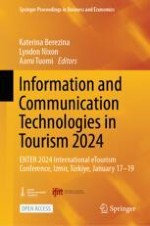1 Introduction
2 Literature Review
3 Methodology
3.1 Data Collection
3.2 Data Analysis
4 Results
4.1 Analysis of the Image Content
4.2 Statistical Analysis

Influencer accounts in total | 50 |
|---|---|
Verified accounts | 6 |
Accounts not verified | 44 |
Business accounts | 25 |
Non-business accounts | 25 |
Number of followers | Frequency | Percentage |
|---|---|---|
1K - 9K | 16 | 32 |
10K - 999K | 34 | 68 |
Total | 50 | 100 |
Model | Non-standardised coefficients | Std. Coeff | t | Sig | ||
|---|---|---|---|---|---|---|
B | Std. Error | Beta | ||||
Model 1 (adj. r2) = .040 Model 2 (adj. r2) = .542 | ||||||
1 | (Constant) | 542.964 | 83.771 | 6.482 | ||
BusinessAccount | −121.586 | 79.958 | −.020 | −1.521 | ||
postsCount | .821 | .057 | .195 | 14.476 | ||
2 | (Constant) | 956.560 | 61.416 | 15.575 | .000 | |
BusinessAccount | −248.850 | 56.429 | −.042 | −4.410 | .000 | |
postsCount | −.521 | .045 | −.124 | −11.542 | .000 | |
followersCount | .014 | .000 | .705 | 66.462 | .000 | |
VerifiedAccount | 2165.770 | 90.294 | .228 | 23.986 | .000 | |
Model | Non-standardised coefficients | Std. Coeff. | t | Sig | ||
|---|---|---|---|---|---|---|
B | Std. Error | Beta | ||||
Model 1 (adj. r2) = .013 Model 2 (adj. r2) = .038 | ||||||
1 | (Constant) | 124.134 | 9.562 | 12.982 | ||
BusinessAccount | − 79.224 | 9.127 | − .118 | − 8.680 | ||
postsCount | − .019 | .006 | − .040 | − 2.928 | ||
2 | (Constant) | 149.828 | 10.017 | 14.958 | 2 | |
BusinessAccount | –91.424 | 9.203 | − .137 | − 9.934 | .000 | |
postsCount | − .061 | .007 | − .130 | − 8.357 | .000 | |
followersCount | .000 | .000 | .184 | 11.991 | .000 | |
VerifiedAccount | − 19.959 | 14.727 | − .019 | − 1.355 | .175 | |
Cluster name | Mean std. Likes | Cluster name | Mean std. Comments | ||
|---|---|---|---|---|---|
C1 | Summer Alps | 0,068 | C8 | Products | 0,0048 |
C2 | Winter Alps | 0,066 | C1 | Summer Alps | 0,0026 |
C6 | Lakes | 0,052 | C7 | People | 0,0024 |
C3 | Urban | 0,047 | C6 | Lakes | 0,0020 |
C9 | Diverse | 0,035 | C3 | Urban | 0,0016 |
C7 | People | 0,034 | C9 | Diverse | 0,0016 |
C5 | Parks | 0,033 | C2 | Winter Alps | 0,0016 |
C4 | Cycling | 0,025 | C5 | Parks | 0,0011 |
C8 | Products | 0,022 | C4 | Cycling | 0,0009 |
